September 2013 Archives
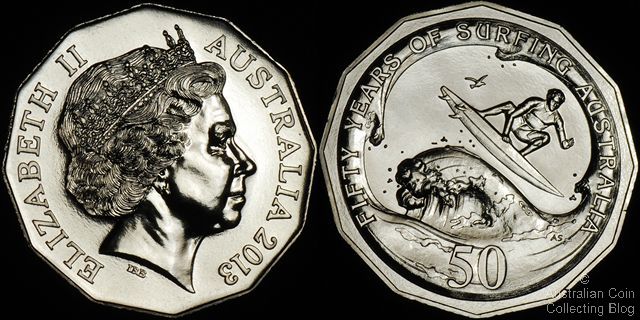
Australia 2013 Fifty Years of Surfing 50c
With surfing so ingrained in Australian culture as a sport and pleasure activity, as well as celebrating the 50th Anniversary of Surfing Australia (as the Australian Surfriders Association), it's no surprise that the Royal Australian Mint would eventually press a coin in tribute to this wonderful sport and in celebration of this great milestone.
And yet it might surprise some to learn that Surfing was "discovered" during Captain Cook's expedition to Australia in 1778. After Captain Cook's death (during a skirmish over a stolen boat), Lieutenant James King continued to update Captain Cook's diaries, adding the first written account on how to ride the waves.
Around 1866, surfing is written about once more, when Mark Twain wrote about his unsuccessful surfing experiences in his book, Roughing It, when sailing to the Hawaii islands. There's not too much written information after that, and sadly at the turn of the century, due to European influences and changes within Hawaii culture, it appeared that surfing had almost died out, with only a few devotees keeping the sport alive.
However in 1907, a friendship formed between three people that would propel the "Sport of Kings" into the limelight.
While visiting Hawaii, American author Jack London was introduced to the sport through his journalist friend Alexander Hume Ford, and from that date on wove his continuing love of surfing into many of his books.
Alexander Hume Ford petitioned for land, forming the Hawaiian Outrigger Canoe Club, the first club dedicated to riding the waves.
Then London and Ford met half-Irish, half-Hawaiian George Freeth on the Waikiki beaches. George just loved to surf and was to become the "Father of Modern Surfing", commencing with a demonstration of his surfing skills during a Redondo-Los Angeles Railway promotional event in California.
And then in 1915, the Australian beach scene was to be changed forever. After winning gold for the 100 metre freestyle swim at the Stockholm Olympics, the NSW Swimming Association invited Hawaiian Duke Paoa Kahanamoku to an exhibition at the Domain Baths, Sydney. During this visit, Duke made himself a board and rode waves at Manly's Freshwater Beach. A whole new Australian culture, lifestyle and language was borne.
So now we have "boogers" (body boarders) and "shubee's" (someone who is all dressed up to surf but has never surfed) and a "hang ten" (the most difficult surfing manoeuver - all ten toes on the nose of the board).
In Australia, you can do a 1 year full-time or 2 year part-time Diploma of Sport Management (Surfing Studies) with Southern Cross University (endorsed by the professional body, Surfing Australia), Gold Coast; or enroll in a 3 year Surf Science and Technology degree at Edith Cowan University, Western Australia.
Our most recent Australian World Professional Surfing Champions include Mark Occhilupo (1999), Layne Beachley (1998-2003 and 2006), Chelsea Georgeson (2005), Mick Fanning (2007, 2009), Joel Parkinson (2012) and Stephanie Gilmore (2007-2010 and 2012) who has the pleasure of being depicted on the unique packaging and highly appropriate surfboard shaped holder of this coin.
The NCLT (non-circulating legal tender) 50 cent Surfing coin is made from cupro-nickel, has a dodecagonal shape (12 sided) and is also found issued in an Australia Post PNC.
The image of a surfer and wave in a wave tunnel border on the coin reverse is designed by Aleksandra Stokic, with the obverse portrait of Queen Elizabeth II by Ian Rank-Broadley.
The 50th Anniversary of Surfing Australia 1963-2013 coin retails at $9, with unlimited mintage but will be determined by collector demand.

Australia 2013 Fifty Years of Surfing 50c in freestanding display card (image courtesy www.ramint.gov.au)
Coins have been in the news quite a bit this year and one of these stories involved the discovery of 700 year old African coins in northern Australia during World War 2. A few small, bronze coins of the short-lived African sultanate of Kilwa (which was on an island off of the modern day country of Tanzania) were found on a beach by an Australian soldier in 1944. He was manning an off-shore radar station on one of the Wessels Islands which are off the coast of Arnhem Land in the Northern Territory, Australia.
In June this year a multi-disciplinary expedition journeyed to the island where the coins were found to conduct a site survey. While they didn't find anything linking the site directly to Kilwa, they did find enough of interest to suggest that ships had been landing on the island since the 1800's at least. Enough to warrant a second expedition to conduct a much more thorough investigation of the island and perhaps an off-shore search to look for wrecks. This expedition is planned for the Australian summer in 2014. And you can help support the expedition or even go along and take part!
The "Past Masters", as they call themselves, have decided to use crowd funding to help finance their expedition. This means you can donate money to help the expedition and depending on how much you help out you'll get some sort of benefit or reward. The Solve the Mystery of Australia's African Coins crowdfunding site is looking for $30,000 of funding. If you donate as little as $10 you'll be personally thanked on the "Past Masters" Facebook page. And if you donate $5,000 you'll get to go along on the expedition! Though we suspect you'll have to pay your own airfares to get to the site where the expedition launches from. Now, while we don't exactly have $5,000 to throw about we can see that those who did would think that $5,000 is a fairly cheap price to pay to go on an expedition that could help write some early Australian history.
We're particularly interested in this expedition because we are lucky enough to be members of the same coin club as the expedition's numismatist, Peter Lane. Peter gave a great presentation at a recent club meeting about the preliminary survey conducted in June and believes that further investigation really is warranted. While we don't expect the expedition to find that African seafarers found Australia in the 1300's it's still a tantalising mystery that should be resolved. And you can take part in helping solve the mystery, for as little as $10! So please head over and donate now and you can pretend (like one of the authors of this blog) that you're Indiana Jones!
The Australian Numismatic Dealers Association (ANDA) organises a number of coin shows each year across the country, but the Sydney show, held around August/September each year, tends to be the largest. Because we were unable to attend this year, we asked gold sovereign dealer Eric Eigner from Drake Sterling Numismatics to put together a short show report on our behalf.
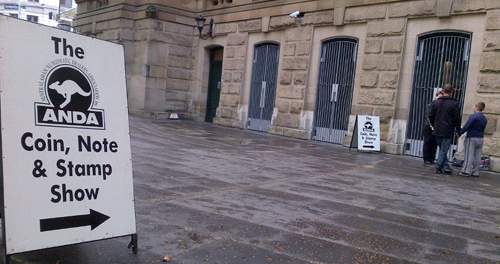
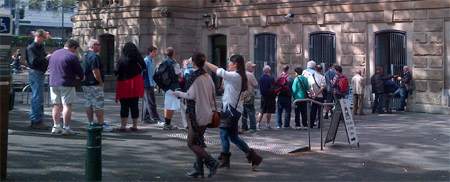
The 2013 Sydney ANDA Coin Show
Of all the coin shows held throughout the year, the ANDA Sydney show has always been my favourite. This year, the show was held on the 14th and 15th of September right in the heart of Sydney's CBD. The weather was great and the traffic into town was good, so as I hauled my wares through the freshly-renovated anteroom of the Town Hall at 8am on Saturday morning, it felt like it was going to be a good show. I wasn't disappointed.
At 10am, a moment before the doors opened, the length of the queue at the front door gave the impression that a celebrity was doing a book signing inside. And when Annette Power, the show organiser, finally swung open the doors, collectors stumbled over each other to get in. The vibe was good.
I had managed to check out some of the dealers stock before the doors opened, and there was a good range. I wasn't surprised that a number of dealers reported good business in the opening hours of the show. Stephen Cole from Salamanca Rare Coins had a great range of world and Australian coins. There was an equally good range of silver florins and brilliant copper coins from Mark Tyson, a dealer from New South Wales. One lucky collector managed to buy a lovely 1942 Bombay penny and a 1940 threepence from Kevin Ayres, a dealer from Canberra. Both coins looked Mint State (from my vantage point over the collector's shoulder), and at only $80 the pair, the coins were a bargain. Ian Pitt from Renniks was cheerful when we chatted and said that collectors were buying coin albums like hotcakes (which indicated to me that collectors must have been buying up coins to fill them with too). John Mulhall from the Coin and Banknote Magazine was also in attendance, as well as variety enthusiast Ian McConnelly.
Sadly, there were a number of dealers who did not attend this year. John Watson from Melbourne, a perennial favourite at ANDA shows (his tables are frequently swamped by bargain-hunting collectors), John Eccles from New Zealand, the ebullient Klaus Ford (whose famously shiny coins were noticeably absent), and of course the Royal Australian Mint all could not attend. One collector noted to me in particular that the absence of the Royal Australian Mint was keenly felt. (Personally, I was hoping to pick up another round of "S"-minted 2013 Holey Dollar counterstamped dollars, but alas I came home empty-handed).
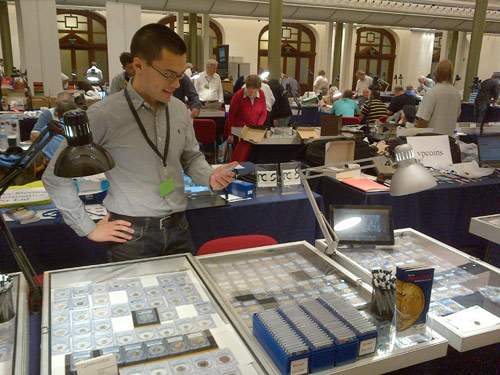
Eric Eigner at the Drake Sterling Numismatics Display
There has been trend over the years toward PCGS-graded coins. Judging by range of dealer stock at the show, it is clear that this trend has not abated. More dealers than ever had at least one PCGS-graded coin for sale, while some dealers, such as myself, had nothing but PCGS-graded coins. Pacific Rim Coins also had a good range of PCGS-certified coins, while there was a small selection of PCGS-graded coins at the Monetarium Adelaide table. Meanwhile, my "bargain bin" of PCGS-graded pre-decimal coins ($25 each or 5 for $100) was nearly sold out.
Overall, it was a good show, and a number of collectors who spent time at my table said the same thing. For the dealers, a lot of stock was sold, while collectors managed to pick up some bargains here and there. I know the collector who picked up my PCGS-graded 1966 proof set for a price less than what he could sell it for at auction was certainly happy. Hopefully, the Melbourne International Coin and Banknote show next month, held for the first time at Etihad Stadium, will be equally as good.
The South Australian Philatelic Council is holding the Annual State Congress for 2013 on the weekend of October 12 and 13. This coin and stamp show is being held in The Drill Hall, Torrens Parade Ground which is located on Victoria Drive in Adelaide, South Australia. The Show is open from 10AM to 6PM on the Saturday and 10AM to 4PM on the Sunday. Admission (we believe) is free. There are a number of show special souvenir stamp issues and cancels available for the stamp collectors among us (which can be ordered directly from here). But of course it'd be much better if you attended the show and bought them in person!
At this stage we're also aware of three coin dealers that will be in attendance, Richard Welling of Ye Olde Coin Co will have several tables, Leo Jakimow will be making the journey from Canberra. And the authors of this very blog will be attending in their alter ego disguises as The Purple Penny. Ye Olde Coin Co always has an eclectic mix of Australian and world coins and Leo Jakimow doesn't attend many shows in South Australia and he has a large range of coins that are well worth the look. And of course we'll bring a range of material including mint product, errors, and various PCGS graded coins. If you happen to see something on our website you'd like us to bring just let us know before hand! Don't forget if you've got coins you'd like valued bring them in too, Richard Welling is always happy to value (and buy collections) and we could have a go at valuing those old coins for you too.
We've attended this show a few times before and there's always a few collectable dealers in attendance who have some interesting stuff. The SA Philatelic Council members put on a good display of philatelic material, and of course there's a canteen available to feed the starving. So, if you're in Adelaide and you're at all interested in stamps or coins then we urge you to attend. We don't have many coin or stamp shows so let's support this one!
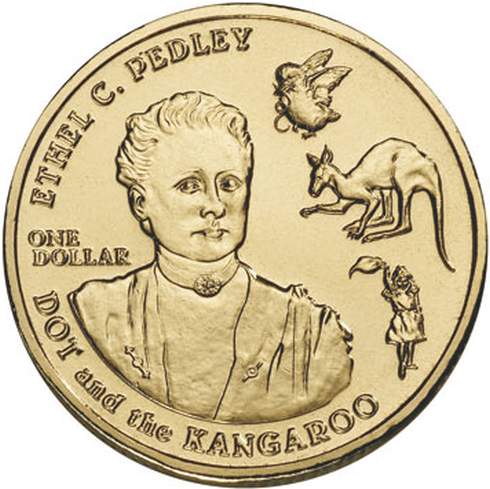
Australia 2012 and 2013 Baby Mint Set 1 Dollar featuring Ethel C Pedley, Author of the Popular Childrens Book Dot and the Kangaroo (image courtesy www.ramint.gov.au)
The much loved and probably the first published Australian children's book "Dot and the Kangaroo" written by Ethel Charlotte Pedley at the turn of the century, has been immortalized on a special commemorative 1 dollar coin featured in the Royal Australian Mint's 2012 and 2013 six coin Australian Baby Mint Set.
Teaching us to live in harmony with the Australian bush and learning how to care for and protect our natural surroundings is the premise behind this delightful children's story. Dot, on an adventure picking wildflowers becomes lost, but is found by the Kangaroo who starts teaching Dot about the value of the Australian bush. By eating "berries of understanding" Dot can understand animal language, learning about their habitats and day to day lives. On returning home, Dot is so appreciative of the kindness and learning extended to her that she assists in building a "safe haven" for the bush animals, far away from the evils of humans who only want to destroy the animal's habitat, and eat and hunt them.
Since 1899, this book has been a best-seller with more than 22 reprints and was adapted in 1977 by Yoram Gross into an award winning film with Spike Milligan's voice as the Platypus. Do you remember this from when you were a kid?
Ethel C Pedley was born in England in 1859, and migrated to Sydney with her parents and three brothers (Arthur, Newland and Oswald) around 1873. Coming from a musical family, Ethel was immersed in the creative arts from a very early age, learning to play the piano at 5, the violin at 17, then winning a medal when in 1880 she attended the prestigious Royal Academy of Music in London.
Back in Australia in 1882 Ethel began teaching singing and violin, and with her friend Emmeline Woolley, founded St Cecilia Choir of Ladies Voices in 1884. Here Ethel conducted the choir, organized concerts, charity events and even wrote musical compositions.
Ethel returned to London in 1896 and managed to coax the Associated Board of the Royal Academy of Music and the Royal College of Music to export their music examinations to Australia, becoming New South Wales' sole representative of the Board in the process.
Sadly, Ethel didn't live to witness the publication of her children's book "Dot and the Kangaroo" in London 1899. She died of cancer at the age of 39 and is buried in the Anglican section of the Waverley Cemetery, Sydney. It's believed that her love affair with the Australian bush developed from the visits to her brother Arthur's station at Morundah, in the Riverina region of New South Wales. Arthur was an accomplished man in his own right - building the Lyric Theatre in George Street, Sydney and other properties after his retirement from farming in 1905.
Before she died, Ethel did arrange for the illustrations to be drawn by Australian Frank Mahony (1862 - 1916), with plates etched by Benton & Bacon of Sydney. Up until around 1901 (when Australia became a Federation) Frank was one of the best-known Australian artist and illustrators, with horses and action scenes being his specialty. Besides his drawings for "Dot and the Kangaroo", his drawings have also appeared in other well known Australian books such as Henry Lawson's "While the Billy Boils" (1896) and "In the Days when the World was Wide" (1900) with the originals being held at the Mitchell Library, Sydney.
The Dot and the Kangaroo Baby Mint Set depicts Ethel C Pedley as the central character on the $1 coin designed by Aaron Baggio (but doesn't bear his initials). She is surrounded by Dot, the Kangaroo and Kookooburra the central characters from the story. It is released as a standard 9 gram 25 millimetre aluminum bronze one dollar coin. The uncirculated Australian Baby Mint set comprises 6 unc coins in total (all standard designs except for the $1) - 5 cent, 10 cent, 20 cent, 50 cent, $1, $2 in Mint packaging and outer cardboard sleeve displaying images from the 1977 film. Also included in this Baby Coin set is a pad printed medallion, photo frame and place to write new baby's birth details with space to record family tree details. It is a fitting gift for a new baby born in either 2012 or 2013. The obverse of the dollar coin and all the other coins in this set is the mature portrait of Queen Elizabeth II by Ian Rank-Broadley.
The Dot and the Kangaroo Baby Mint Set retails locally at $45 with mintage numbers to be determined by its demand. The 2012 and 2013 Baby Proof Set also carries the Dot and the Kangaroo theme but it's the Baby Mint (uncirculated coin) Set that includes the unique Ethel C Pedley 1 dollar coin seen above. Buying the Baby Mint Set is the only way to secure this Australian dollar coin minted in 2012 and 2013.
Prior to 2012 the 2009, 2010 and 2011 Baby Mint Sets featured the Dorothy Wall Dollar and were themed around her book and characters of Blinky Bill.
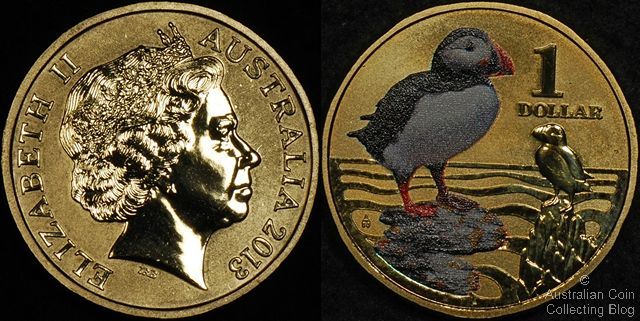
Australia 2013 Atlantic Puffin Coloured 1 Dollar
The Altantic Puffin is one of the last coloured dollar coins in the Royal Australian Mint's Polar Animals series. The series focuses on animals that live in some of the coldest areas in the world. This reverse, a coloured bird, the Atlantic Puffin.
Did you know that the Atlantic Puffin is the official bird emblem of Newfoundland and Labrador in Canada?
And that the British Island of Lundy (which in Norse means "puffin island") may have been used by the Vikings to rest and restock their food supplies, before and after their mainland raids.
The self-declared 'King of Lundy' who was really just an English businessman Martin Coles Harman purchased Lundy in 1925 and struck unofficial currency for the island in 1929, the denomominations the half puffin and puffin! These fantasies were restruck in 1965 and 2011. The puffin has also appeared on Canadian currency.
School children from the 1940's probably remember being a member of the Puffin Book Club and owning a much loved children's Puffin paperback.
The Atlantic Puffin's most prominent feature is their triangulated beak, which becomes exceptionally colourful in the breeding season, giving them the nickname "parrots of the sea".
They've also been called the "clown of the sea", having some rather unusual mannerisms. Dominance is shown to one another by standing as upright as they can, fluffing out their chest feathers and cocking their tails, then walking very slowly past one another in a very exaggerated manner, all the while jerking their heads and gaping their beaks. Those that show subservience will lower their heads, position their body in a low horizontal manner and scurry past the dominant Puffin as quickly as they can.
And then there's "billing" (or "kissing"), the ritual performed by reuniting Puffins prior to and right through the mating season. As they approach one another, they wag their heads from side to side and rattle their beaks together.
Puffins were thought to be monogamous, but scientists now believe that their "true love" is their nesting sites, returning to the same burrow each year. They're very solitary animals and spend most of the winter out at sea. Because of this it's unclear if mating couples meet first out at sea or when returning to the burrow. Either way, coming back to the same burrow each year is probably just the most efficient way to ensure they connect with the right mate.
Female Puffins will only lay 1 egg during the mating season, but if "lost" early in the season, another egg may be laid. Baby chicks are called "pufflings."
Seals, large fish, the Great Black-backed Gull and the Great Skua are the Puffins natural predators. When bobbing around on the ocean, Puffins are often seen putting their head underwater scouting for predators. Aerial acrobatics and wheeling around cliff faces come in very handy to outmanoeuver flying predators.
Man however, has yet again, played a part in being a significant threat to Puffins - from hunting for meat, to removal of eggs, through to feathers being used for bedding & insulation. Feral animals have also been introduced into the Puffin's territory - such as on the Island of Lundy with the numbers decreasing in 2000 to just 10 pairs of breeding birds due to a rat plague, the rats being responsible for eating eggs and young chicks.
Oil spills also reduce Puffin numbers. When a bird's feathers become "oiled" they are less able to insulate themselves, becoming vulnerable to temperature changes and reduced buoyancy at sea.
Global warming however, may be benefiting the Atlantic Puffin. As sea surface temperature rises, so does plankton abundance, which in turn stimulates the small fish populations that Puffins eat.
The Atlantic Puffin coin is released as a standard 9 gram 25 millimetre dollar coin. The reverse frosted uncirculated finish is a design by Aaron Baggio, with the obverse portrait of Queen Elizabeth II by Ian Rank-Broadley. This coin is one of six coins in this series -previously released coins depict the Polar Bear, Rockhopper Penguin, Weddell Seal, Walrus and the Humpback Whale. The Polar Animals series follows the successful Animals of the Zoo Series of 2012 and the Air, Land and Ocean series of previous years.
As with previously issued coins, the Atlantic Puffin coin retails at $15 and is presented in a colourful collector's card. Mintage is unlimited at this time and will be determined by collector demand. This coin is listed in our 2013 1 dollar coin mintages table, see the variety of Australian dollar coins issued in 2013.


